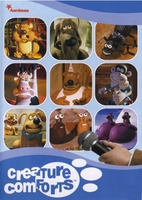
Creature Comforts, the ITV series which started life as an Oscar-winning short film in 1989, might, at first glance, best be described as a documentary; its vox pop format providing a platform for the genuine, unscripted opinions of the British public. However, what appears on screen is anything but reality, as these voices are given to animated plasticine animals in a variety of settings – in this case, the circus.
After a range of other ‘animals’ have given their views on clowns, we hear from a lion and a Labrador guide dog. The lion views the appearance of clowns in a circus show as ‘quite insulting’ to other more skilled performers, whilst the dog, speaking in a markedly lower register, shows her appreciation for clowns, pointing out that making people laugh requires talent.
Though they are complete opposites, the ideas expressed by these characters are not terrifically unusual. Based on their delivery, listeners may respond more favourably to either opinion. The former is an insider and may have the best understanding of the business, but the latter’s enthusiasm and simplicity is endearing. However, changing the context of genuine interviews with ordinary people by framing their opinions in the animal world allows their views to take on different meanings.


A vast contrast in enthusiasm between the lion and the dog.
The first animal being a lion, the interviewer is naturally uneasy about standing so close. Though unseen, their human hand clearly quivers, whilst a stool is being held ready to push the lion away, should she choose to pounce. We have already seen that the lion tends to be grumpy, but the interviewer’s response only adds to the sense of her hostility, which the lion does nothing to relieve. The next scene portrays a creature who couldn’t be more different – a guide dog. In such a role, she is clearly caring and sympathetic, but crucially, she is also an outsider – the only animal featured in the episode who is not a performer at the circus. This gives her an elevated status as the representative voice of the common person – the voice of us – and her wide eyes and enthusiastic expressions only make her more endearing and sympathetic. The filmmakers create personas based entirely on the interviewees’ ideas on a given subject – an animalistic caricature based on opinions rather than looks – and in doing so, they create meaning (or, more crucially, comedy) where previously, there was none.
Clearly, the delicate decision of which animal best fits each interviewee is motivated by humour – Creature Comforts is billed as a comedy, and it is the work done by the filmmakers following the interviews which makes the show funny. The animals in their settings, as well as the editing, combine to alter the original intentions of the interviewees, as spotlights are thrown on particular traits which serve to caricature otherwise unremarkable ideas and opinions. By using animals to recontextualise the banality of everyday life, Creature Comforts allows viewers to find humour and intrigue in even the most recognisable situations.